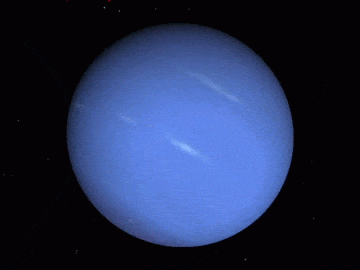Neptune
 |
| [1] Neptune |
Neptune which is approximately 4.503 billion years old is the eighth and last planet within the solar system and the furthest away planet from the sun. Being an 'Ice Giant', Neptune's atmosphere consists mostly of Hydrogen (80%), Helium (19%), Methane (1.5%) and water and as previously spoken about in the blog 'Uranus', methane "absorbs the red light from the sun but reflects the blue light from the sun back into space" [2] which results in its blueish colour. Out of all the planets within the solar system, Neptune has the slowest orbital period taking 165 Earth years to make one full orbit around the sun and also has the slowest orbital speed of any planet with speeds averaging just 12,148 miles per hour. Similar to Jupiter, Neptune suffers from extreme winds and storms but it has been proven that Neptune seems to take the record for the highest wind speeds of any planet with "1,200 miles per hour" [3] compared to Jupiter's 384 miles per hour. The reason why this planet suffers from these intense storms is due to the fact that "like Jupiter and Saturn, Neptune generates more energy than it receives from the sun, and this energy radiating from the planet's core is what drives the strong surface winds." [3]. The video below helps explain the planet in more depth:
Another interesting feature about Neptune is it too has it own thin set of rings like Saturn and Uranus. These rings "are likely made up of ice particles mixed with dust grains and possibly coated with a carbon-based substance" [5] but it is still not proven due to the lack of space exploration of this planet with only one successful spacecraft 'Voyager 2' passing its atmosphere in 1989. The Spacecraft even captured some of Neptune's 14 moons with one of its moons named Triton being "shown to not only be the most intriguing satellite of the Neptunium system, but one of the most interesting in all of the solar system" [6] with images displaying "active geyser-like eruptions spewing invisible nitrogen gas and dark dust particles several kilometres into the tenuous atmosphere" [6]. Overall, with still many questions to be answered about this mysterious planet, Neptune is by far one of the most interesting planets within the solar system and with many more mission to come, hopefully astronomers will gain a better understanding of this remarkable planet.
References:
[1] gifs.com. [n.d.]. Neptune Rotation animated gif. [Online] Available at: https://gifs.com/gif/neptune-rotation-yED5n7 [Last Accessed 30/10/2020].
[2] coolcosmos.ipac.caltech.edu. [n.d.]. Why is Neptune blue?. [Online] Available at: https://coolcosmos.ipac.caltech.edu/ask/138-Why-is-Neptune-blue-#:~:text=Neptune's%20atmosphere%20is%20made%20up,is%20why%20Neptune%20appears%20blue. [Last Accessed 30/10/2020].
[3]Deziel, C. [2017]. What Is the Wind Speed on Neptune?. [Online] Available at: https://sciencing.com/what-wind-speed-neptune-4727681.html [Last Accessed 30/10/2020].
[4] National Geographic. [2019]. Neptune 101. [Online] Available at: https://www.youtube.com/watch?v=NStn7zZKXfE [Last Accessed 30/10/2020].
[5] spacefacts.com. [n.d.]. Neptune Facts. [Online] Available at: https://space-facts.com/neptune/ [Last Accessed 30/10/2020].
[6] voyager.jpl.nasa.gov. [n.d.]. Voyager - Fact Sheet. [Online] Available at: https://voyager.jpl.nasa.gov/frequently-asked-questions/fact-sheet/ [Last Accessed 30/10/2020].

Comments
Post a Comment